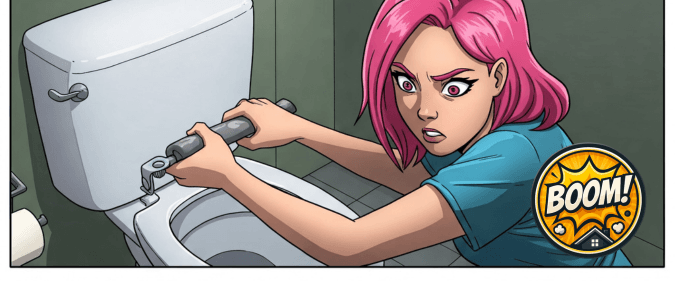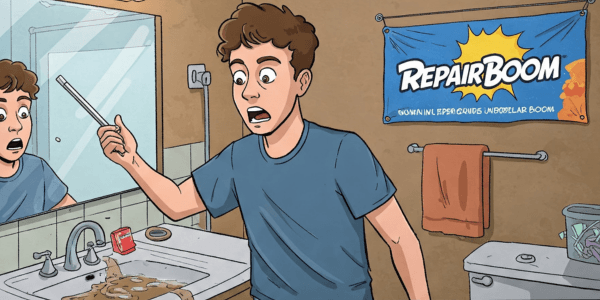Lets get started fixing your loose toilet handle

- Lets get started fixing your loose toilet handle
- Introduction – How to Fix a Loose Toilet Handle
- Why is My Toilet Handle Loose? (Common Causes)
- Tools You'll Need (Probably None!)
- Step 1: Prepare the Tank
- Step 2: Locate the Mounting Nut
- Step 3: Tighten the Mounting Nut
- Step 4: Check the Chain/Lever Connection (Optional but Good)
- Step 5: Test the Flush
- When NOT to DIY (Call Maintenance)
- FAQ – How to Fix a Loose Toilet Handle
Introduction – How to Fix a Loose Toilet Handle
Is there anything more annoying than reaching to flush the toilet and grabbing a handle that jiggles, wobbles, or feels like it’s about to fall off? A loose toilet handle is a common household nuisance, but the good news is that it’s usually one of the easiest plumbing fixes you can tackle yourself as a renter. Before you put in a maintenance request (and potentially wait), you can often solve this problem in just a few minutes with minimal or even no tools required. This guide will walk you through the simple steps to tighten that wobbly handle and restore a satisfying flush.
Why is My Toilet Handle Loose? (Common Causes)
Nine times out of ten, a loose or wobbly toilet handle isn’t a sign of a major plumbing disaster. The culprit is almost always the mounting nut located on the inside of the toilet tank. This nut holds the handle assembly securely against the porcelain tank wall. Over time, with repeated flushing, this nut can gradually loosen, causing the handle to feel unstable. Occasionally, the connection between the handle’s lever arm and the flush chain inside might also contribute to a feeling of looseness, but the mounting nut is the primary suspect.
Tools You’ll Need (Probably None!)
This is often a tool-free repair!
- Your Hands: Usually sufficient to tighten the nut.
- Adjustable Wrench or Pliers (Optional): ONLY if the nut is stubborn and won’t tighten by hand. Use with extreme caution!
- Old Towel or Rag (Optional): To place under the tank lid when you remove it, preventing scratches.
Safety First: While this is a simple fix, the main risk is over-tightening the mounting nut, which can crack the porcelain toilet tank – turning a minor annoyance into a major problem. Always start by hand-tightening and only use a tool very gently if absolutely necessary.
Step 1: Prepare the Tank
Before you can tighten anything, you need to access the inside of the toilet tank.
- Remove the Tank Lid: Carefully lift the heavy porcelain tank lid straight up and set it aside gently on a protected surface (like an old towel on the floor or closed toilet seat) where it won’t get knocked over or chipped.
Step 2: Locate the Mounting Nut
- Look Inside: Peer inside the now-open toilet tank.
- Follow the Handle: Trace the toilet handle from the outside lever to where it passes through the tank wall.
- Find the Nut: On the inside, you’ll see the end of the handle assembly sticking through. There will be a plastic or metal nut threaded onto it, holding it against the inner tank wall. This is the mounting nut you need to tighten. It might be wingnut-shaped or hexagonal.
(Image Placeholder: Diagram showing the inside of a toilet tank with an arrow pointing to the handle mounting nut)
Step 3: Tighten the Mounting Nut
This is the core of the fix. Remember the caution about over-tightening!
- Check Thread Direction: Most toilet handle mounting nuts are reverse-threaded. This means you usually turn them COUNTER-CLOCKWISE (to the left when looking down at it from above) to tighten them, and clockwise to loosen. This is opposite to standard nuts and bolts. Confirm by trying to turn it slightly counter-clockwise first.
- Hand-Tighten: Grip the nut securely with your fingers and turn it counter-clockwise (or clockwise if you discover it’s standard-threaded, though less common) until it feels snug against the inside of the tank wall. Wiggle the outside handle gently as you tighten to ensure it’s seating properly. Often, hand-tightening is all that’s needed.
- Tool Tighten (If Necessary & WITH CAUTION): If the handle is still loose after hand-tightening, gently use an adjustable wrench or pliers to turn the nut just a tiny bit further (maybe 1/8th to 1/4 turn). DO NOT CRANK ON IT. Apply minimal force. The goal is snug, not excessively tight. Stop immediately if you feel significant resistance or hear any cracking/creaking sounds.
Step 4: Check the Chain/Lever Connection (Optional but Good)
While the tank is open, quickly check the connection between the handle’s internal lever arm and the flapper (the rubber seal at the bottom of the tank).
- Inspect: Ensure the chain or strap isn’t tangled, twisted, or caught on anything.
- Check Slack: The chain should have just a slight bit of slack when the flapper is closed. Too much slack can cause an incomplete flush or require you to hold the handle down. Too little slack (or being too tight) can prevent the flapper from sealing properly, leading to a constantly running toilet. (If your toilet runs constantly, see our guide on
[how-to-fix-a-running-toilet]). - Adjust if Needed: Most chains have multiple holes or a clip to easily adjust the length. Make small adjustments if necessary.
Step 5: Test the Flush
- Replace Lid: Carefully place the tank lid back onto the tank, ensuring it sits correctly.
- Test Handle: Wiggle the handle. It should now feel firm and stable.
- Test Flush: Flush the toilet normally. Ensure the handle operates smoothly and the toilet flushes and refills completely without the handle sticking or the water running continuously.
When NOT to DIY (Call Maintenance)
This DIY fix only works if the issue is simply a loose mounting nut or chain adjustment. You should stop and submit a maintenance request if:
- The handle lever itself is cracked or broken.
- The internal lever arm (connecting the handle to the chain) is snapped or severely bent.
- You notice any cracks in the porcelain tank, especially around the handle opening.
- You cannot tighten the nut without excessive force, or it just keeps spinning (stripped threads)
Disclaimer: This article provides general information. Exercise caution when using tools. Consult with your landlord or a professional if you are unsure about any step.
FAQ – How to Fix a Loose Toilet Handle
Do I need to turn off the water supply to tighten the toilet handle?
No, typically you do not need to shut off the water supply valve for this specific repair. You are only working on the external handle mechanism and the nut inside the tank, above the water line when the tank is full.
Why is the nut inside the tank usually reverse-threaded?
This is a common design choice to prevent the nut from loosening itself during the normal operation of the handle. Since you typically push the handle down (which might cause a slight clockwise rotation force on the internal mechanism), making the tightening direction counter-clockwise helps ensure the flushing action doesn’t inadvertently loosen the nut over time.
What happens if I overtighten the nut and crack the tank?
Cracking the porcelain tank is a serious issue that will cause a leak and require the entire toilet tank (or potentially the whole toilet) to be replaced. This is why it’s crucial to only hand-tighten first and use tools with extreme gentleness, stopping immediately if you feel too much resistance. If you accidentally crack the tank, you should turn off the water supply to the toilet immediately and contact your landlord or maintenance.
My handle is tight, but the toilet doesn’t flush properly. What else could be wrong?
If the handle itself is secure but the flush isn’t working right, the issue is likely with the internal components. Check the chain/strap connecting the handle lever to the flapper (Step 4) – it might be disconnected, tangled, too loose, or too tight. The flapper itself might also be worn out and not sealing or lifting correctly. (See our guide on how-to-fix-a-running-toilet for more troubleshooting on flush issues).

How to Mount a TV on the Wall in 3 Easy Steps | Free Guide
Defining Uninhabitable: California’s Rental Housing Requirements
How to Get Your Security Deposit Back After Moving Out: In 4 Easy Steps


